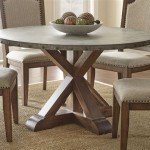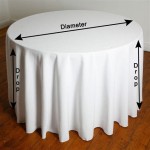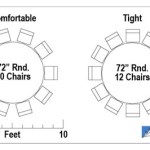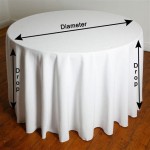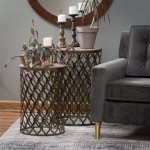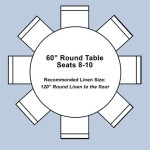How To Make A Large Tablecloth Fit A Smaller Table Without Cutting
Tablecloths are integral to enhancing the aesthetic appeal of dining and event spaces. They protect the underlying table surface from spills, scratches, and other potential damage. However, the situation often arises where a larger tablecloth is available but needed for a smaller table. Cutting the tablecloth is generally not the optimal solution due to potential fabric damage, hemming requirements, and the loss of the tablecloth's original size for future use on larger tables. Several alternative methods exist to effectively manage an oversized tablecloth on a smaller table without resorting to permanent alterations. These methods prioritize maintaining the integrity of the tablecloth while achieving a presentable and functional setup.
The methods discussed here involve strategic folding, pinning, and the utilization of accessories to adjust the tablecloth's dimensions to fit the target table size. The selected approach depends on the tablecloth material, the desired aesthetic, and the level of formality required. Each technique offers a unique blend of practicality and visual appeal, allowing for flexibility in adapting to various circumstances.
Strategic Folding Techniques
Folding is arguably the simplest and most reversible method for adapting a larger tablecloth to a smaller table. Several folding techniques can be employed, each offering a different visual outcome and level of adjustment. The primary objective is to redistribute the excess fabric in a manner that minimizes bulk and creates a neat, aesthetically pleasing drape.
The simplest approach involves folding the excess fabric underneath the tablecloth. This method works best for tablecloths that are only slightly larger than the table. The process involves carefully lifting the edges of the tablecloth and folding the excess material inwards, underneath the table surface. The folded edges should be smoothed out to prevent unsightly creases or bumps. This technique is quick and requires no additional tools or materials, making it ideal for informal settings or when time is limited.
Another folding technique involves creating pleats or tucks along the edges of the tablecloth. This method is more suitable for significantly oversized tablecloths. The excess fabric is gathered and folded into even pleats or tucks, which are then secured with safety pins or tablecloth clips on the underside of the table. The pleats should be evenly spaced and consistent in size to create a balanced and professional appearance. This technique allows for greater control over the amount of fabric reduction, making it adaptable to a wider range of size discrepancies. It also adds a subtle textural element to the tablecloth's drape.
For round or oval tables, folding techniques can be adapted to follow the curvature of the table's edge. The excess fabric can be gathered and folded inwards, creating a series of radial pleats or tucks. The key is to maintain uniformity in the pleats to ensure a smooth and even drape. Utilizing a circular template can help in achieving consistent pleat spacing. Alternatively, the tablecloth can be folded into a square or rectangle that approximates the table's dimensions, leaving decorative corners that drape towards the floor. This approach can create a more structured and formal look.
Utilizing Tablecloth Clips and Pins
Tablecloth clips and pins provide a secure and discreet method for managing excess fabric. These accessories are particularly useful for preventing the tablecloth from shifting, especially in outdoor settings or when the table is subject to movement. They also allow for more precise control over the tablecloth's drape and can be used in conjunction with folding techniques to create a polished appearance.
Tablecloth clips are designed to grip the edge of the table and hold the tablecloth in place. They come in a variety of styles, materials, and sizes, allowing for selection based on the tablecloth's thickness and the table's edge profile. For a seamless look, transparent or color-matched clips are recommended. They can be strategically placed around the table's perimeter to secure the excess fabric in a neat and uniform manner. Ensure that the clips are evenly spaced to distribute the tension and prevent any one area from bearing too much weight. This helps prevent the tablecloth from sagging or slipping.
Safety pins, while less aesthetically refined than tablecloth clips, offer a versatile and cost-effective solution for securing excess fabric. They are particularly useful for creating pleats or tucks, as described in the folding techniques section. When using safety pins, exercise caution to avoid damaging the tablecloth fabric. Use small, fine-point pins and ensure they are securely fastened to prevent accidental opening. Invisible stitches can also be utilized in areas to keep pleats and folds secure, minimizing safety concerns. The pins should be concealed on the underside of the tablecloth to maintain a clean and professional appearance. For delicate fabrics, consider using specialized pins designed for knitwear or silk to minimize the risk of snags or runs.
Another option is to purchase specific tablecloth weights or magnets. These attach to the corners or hem of the tablecloth, adding weight and preventing it from billowing or shifting. This is a subtle solution for preventing excess fabric from being a hassle, especially in breezy conditions and can add a touch of elegance and sophistication to the table setting.
Creative Drapping Solutions
Beyond simple folding and pinning, more creative draping solutions can transform an oversized tablecloth into a visually striking element. These techniques involve manipulating the fabric to create unique shapes, textures, and layers, adding depth and interest to the table setting. This approach is particularly suited for situations where visual flair takes precedence over strict adherence to traditional tablecloth etiquette.
One popular technique involves creating a "waterfall" effect by allowing the excess fabric to cascade down one or more sides of the table. This can be achieved by positioning the tablecloth asymmetrically, leaving a significant portion of the fabric to drape over one or two edges. The cascading fabric can be styled in various ways, such as creating soft folds, sharp pleats, or even incorporating decorative elements like ribbons or floral arrangements. The overall effect is one of effortless elegance and can be particularly effective for long tables or dessert buffets.
Another draping solution involves layering the oversized tablecloth over a smaller, contrasting tablecloth or runner. This creates a visually rich and textured effect. The smaller tablecloth or runner can serve as a base layer, providing a foundation for the larger tablecloth to drape over. The excess fabric from the larger tablecloth can be arranged in a variety of ways, such as creating a border around the smaller tablecloth or allowing it to cascade down the sides in a waterfall effect. This technique allows for creative experimentation with color, pattern, and texture, adding a personalized touch to the table setting.
Consider using belts or sashes to cinch the tablecloth. Cinching the fabric with a belt or ribbon can create an hourglass shape or a more defined waistline, adding visual interest and dimension to the table setting. This works particularly well with heavier fabrics that have a good drape. Experiment with different materials and colors for the belt or sash to complement the tablecloth and the overall decor. The belt can be placed at different heights to adjust the amount of fabric that drapes below the table.
Incorporate decorative elements, such as flowers, garlands, or string lights, to enhance the draped effect. These elements can be strategically placed along the edges of the tablecloth or within the cascading folds to add visual interest and create a more inviting atmosphere. The key is to choose decorative elements that complement the overall style and theme of the event or occasion.
By employing these strategic folding techniques, utilizing tablecloth clips and pins, and exploring creative draping solutions, it is possible to effectively adapt a larger tablecloth to a smaller table without cutting or permanently altering the fabric. The chosen method will ultimately depend on the specific circumstances, including the tablecloth material, the table size, and the desired aesthetic. With careful planning and execution, the outcome can be a beautifully draped table that enhances the overall ambiance of the space.

How To Make A Tablecloth Fit Any Table Shape Or Size O Sewing

How To Make A Tablecloth Fit Any Table Shape Or Size O Sewing

How To Make A Tablecloth Fit Any Table Shape Or Size O Sewing

60 Second Diy Fitted Rectangular Tablecloth Cv Linens

How To Make A Tablecloth Fit Any Table Shape Or Size O Sewing

How To Make A Tablecloth With Pictures Wikihow

Fitted Table Cover The Easy Diy

How To Make A Tablecloth Farmhouse Style The Latina Next Door

No Sew Diy Tips And Tricks On Cutting Fabric More Easy Elegant Tablecloth

Toddlers Damaging Your Furniture A Quick Diy Cornered Tablecloth You Can Sew In Just One Hour
Related Posts

